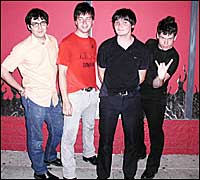 Mark Dery synthesizes the newest fringes of our culture into a united media interrogation of postmodernity. His books and countless articles place cyberculture, posthumanism, artificial intelligence, underground music, science fiction, etc. under a shrewd lens of inquiry and he returns adept insights and new ideas.
Mark Dery synthesizes the newest fringes of our culture into a united media interrogation of postmodernity. His books and countless articles place cyberculture, posthumanism, artificial intelligence, underground music, science fiction, etc. under a shrewd lens of inquiry and he returns adept insights and new ideas.
Overlooked and underrated, Mark Dery should be added to the short list of valid modern visionaries.
Roy Christopher: Many of the subjects in your analyses of cyberculture tend to have a “pro” or “con” view of the exponential progress of technology. What’s your personal take on our current overdrive technological progress?
Mark Dery: Well, if by “overdrive” you mean the runaway speedup of techno-evolution, I think we need to learn to philosophize in a wind tunnel. We tend to mime our speed culture rather than make sense of it. The smeared graphics and train wreck typography of designers like David Carson, formerly of RayGun magazine, are one example of this mimesis; “blipcore” techno that buzzes by at heart-attack tempos is another. We live in the age of blur; to understand who we are and where we’re going as a wired society, we need to be able to sketch an exploded view of the cultural bullet train as it streaks past at full throttle. The dug-in, hunkered-down stance of cyberpundits like David Shenk, who fulminates against “life at hyper-speed” and keeps his TV in his closet, is a bunker mentality. No one’s going to stop the world so we can get off. The info-vertigo we’re suffering from, the unrelieved sense of personal disorientation and social dislocation, is going to be a fact of life from now on — deal with it. Obviously, I’m not saying that we should throw out our moral compasses just because there’s no one true magnetic north, culturally speaking, anymore. My personal take on the breathless hyperacceleration of technological change and the social upheaval it’s causing is that, rather than consign unfashionably “humanist” notions of social justice and political change to the recycle bin of history, we have to learn how to be moral animals in a world where all the old, comforting bedtime stories about God and progress and the providential hand of the free market are deforming and disintegrating as our culture, our increasingly posthuman technology, accelerates away from our nature — human psychology, which is still bounded and shaped by those evolutionary artifacts we call bodies. That’s what a lot of my writing and thinking is about.
RC: With the enthusiasm for externalization and “leaving the flesh behind” that has come along with advances in technology, do you foresee a renaissance of the “Human Factor” coming as the next wave?
MD: We have to ask what “The Human” is? That’s the vexed question. When I interviewed David Cronenberg (in my parallel-dimension life as a journalist), he professed bafflement about the very notion that we’re becoming posthuman. To him, the media’s colonization of our inner landscapes and the cyborgian offloading — into ever-smarter, increasingly lively machines — of more and more of our mental and physical functions is all too human. Humans are tool-using apes — signifying monkeys — and technology is part of us, at this late date. Even so, there’s a spontaneous recoil from the suggestion that the alien in the mirror is us. That’s the parable of the Unabomber, who inveighed against technology while hacking together nasty little pieces of exploding hardware and writing apocalyptic manifestos on a rattletrap typewriter. Where does nature (what you call the “Human Factor”) end and culture (technology) begin? The Unabomber didn’t include the typewriter in his technological demonology, which is a curious sin of omission. According to the SF novelist J.G. Ballard, the typewriter is a cyborg incubator: it encodes us, stamping the linear bias of the assembly line, and all of industrial modernity, across our imaginations. The distinction between ourselves and our tools is becoming increasingly arbitrary — more and more of a reassuring fiction — and the anxiety provoked by the blurring of this once clear-cut distinction manifests itself in the fetishizing of the “Human Factor.” The “renaissance” you’re talking about is already upon us. Mail-order catalogues from Smith & Hawken and Pottery Barn and other merchandisers of gracious living abound in “distressed” faux antiques and pseudo-Shaker furniture and ersatz Arts & Crafts housewares — mass-produced talismans of a time before mass production, when the human touch left its traces on everyday objects. To be sure, these sorts of commodities are partly about shoring up one’s social standing with icons of timeless good taste, but they’re also about the veneration of the handmade, i.e., the human touch, and of objects “humanized” by the passage of time, transformed from generic things into weathered, worn, one-of-a-kind treasures with pedigrees and personalities.
RC: What are some of the newer areas of technological advancement and the sociological ramifications thereof (that you haven’t already researched) that have sparked your interest?
MD: The new plastics that have enabled the current renaissance in industrial design, emblematized by the soft, biomorphic, translucent “blobjects” spawned by the iMac. Quantum computing. Xenotransplantation and the engineering of transgenic animals. The far fringes of comparative ethology, where researchers are exploring the no man’s land between human and animal intelligence.
RC: For those who haven’t yet read it, what can you tell our readers about your newest book, The Pyrotechnic Insanitarium (Grove Press, 1999)?
MD: Like many, I feel as if contemporary America is an infernal carnival, equal parts funhouse and madhouse — a “pyrotechnic insanitarium,” to borrow a turn-of-the-century nickname for Coney Island. In The Pyrotechnic Insanitarium: American Culture on the Brink, I wonder: Are social forces such as the yawning chasm between rich and poor tearing the fabric of American society to shreds? Or are our premonitions of cultural chaos just a toxic cocktail of turn-of-the-millennium fever and media-fueled hysteria? I find the answers in Oklahoma bomber Timothy McVeigh ‘s visions of black helicopters and the Heaven’s Gate cultists’ fantasies of alien saviors; in Disney’s planned town, Celebration; and Nike’s dreams of global domination. Along the way, I puzzle over the popularity of blow-up dolls of Edvard Munch’s The Scream and wonder what, exactly, Jim Carrey’s talking butt is trying to tell us. The Pyrotechnic Insanitarium is a theme-park “dark ride” through contemporary America, a culture torn between angels and aliens, the smiley face and The Scream. Keep your hands inside the moving vehicle at all times!
RC: Who do you admire doing science right now? Who do you consider to be truly forging new paths? And who do you like that’s reporting these paths?
MD: Truth to tell, I’m not much of a disciple of science. I read social histories and cultural critiques of science; my “hard” scientific reading is strictly Homer Simpson fare — magazines like The Sciences and Smithsonian, the science page of The New York Times (despite the unabashedly pro-business flackery of Times science reporter Gina Kolata, recently exposed in an excoriating cover story in The Nation). I’m a great fan of Stephen Jay Gould, a luminous scientific mind who has the political virtue of being on the side of the angels — that is, whatever side the unreconstructed sociobiologist Richard Dawkins isn’t on. And he’s ferociously funny — a vanishingly rare trait among popularizers of science. Also, the popular science writer Timothy Ferris is always enlightening and entertaining. But my favorite writer on science and technology remains J.G. Ballard, the SF visionary and postmodern philosopher par excellence, whose ruminations on our over-lit media landscape, stalked by “the specters of sinister technologies,” are an inexhaustible mother lode of brilliant insights and mordant bon mots.
RC: Do you have any projects in the works you’d like to mention?
MD: I just signed on as editor of ArtByte, a magazine of digital culture — formerly a magazine of digital art, as its name suggests — whose roll call of contributing writers includes Bruce Sterling, Erik Davis, and other SF/cybercrit writers familiar to your readers. I’ve been charged with radically reconceptualizing the magazine as a smart, snarky meme-splice of I.D. (the American design magazine, not the British youthstyle mag), The Baffler, and the late, much-lamented Australian cyberzine, 21C, with a dash of Suck.com at its best. It will feature coverage and criticism of e-culture, targeting the terminally wired, and the incurably informed: readers who feel at home in what Alvin Toffler called “blip culture,” readers with rapacious media appetites who thrive on information overload but want to engage critically with the ever more mediated world around them. I’m frantically brainstorming a plan for global domination.
At the same time, I’m juggling several book ideas, one about the insect as cultural icon, another a social history of irony. Then, too, there’s “My Dinner With Hannibal,” the mash note to Hannibal Lecter I’ve always wanted to write — a literary dissection of the haute-couture cannibal in the age of Martha Stewart. With the return of ’80s-style greed-is-good meanness and conspicuous consumption (symbolized by the grotesque hypertrophy of the American car into the gargantuan SUV), it seems like an idea whose time has come.





 Douglas Hofstadter, College Professor of cognitive science and computer science, director of the Center for Research on Concepts and Cognition, adjunct professor of philosophy, psychology, history and philosophy of science, and comparative literature at Indiana University, never sleeps. The man is always thinking. About thinking.
Douglas Hofstadter, College Professor of cognitive science and computer science, director of the Center for Research on Concepts and Cognition, adjunct professor of philosophy, psychology, history and philosophy of science, and comparative literature at Indiana University, never sleeps. The man is always thinking. About thinking. 


